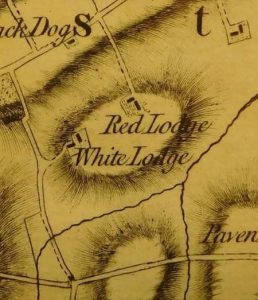
Wiltshire Buildings Record held its 40th AGM in Bratton on the 22nd June 2019. The weather was beautiful and a miraculous interlude in a succession of grey, stuffy days that had come before. After the business meeting Mike Manson of the Bratton History Association (BHA) gave us a presentation on the origins and development of Bratton, which was apparently once three separate settlements.
The wealth of fine houses hidden down picturesque lanes were derived from the woollen industry in the 17th and 18th centuries. West Wiltshire was dominated by a small group of entrepreneurs who controlled the woollen industry as landholders, buyers and employers. The most prominent family in Bratton and Westbury was the Whitakers; wool merchants whose impressive home was the Courthouse in Court Lane, dating from the medieval period and onwards.
Iron replaced wool in the 19th century, as Dennis Gardner, another BHA member explained in a separate presentation. Reeves ironworks produced agricultural machinery and was the largest employer in Bratton until the early 20th century.
Fuelled by much cake and tea, we went out down a positive rabbit-warren of unexpected leafy lanes, guided by Mike. Owners of houses were moved to come out and investigate at the sight of a large bunch of strangers all staring steadily in their direction. All were friendly though, and a mine of information.
Much of the timber-framing we saw appeared to be 17th century, or 17th century improvements of earlier buildings. In at least two cases this included a chute at the front, possibly to load fleeces directly into a wool loft at the top of a house (as found in a WBR recording of Court Lane farmhouse a few years back). There was much speculation over this, with the conclusion that many villages had their own peculiarity in building, influenced by the prevailing economic activity. In Bratton’s case this being its woollen industry in the 17th century and possibly later. As usual though, more research is needed to prove this link.
Dorothy Treasure
Principal Buildings Historian, Wiltshire Buildings Record





 The King’s Arms, at the junction of Church Hatch and High Street, a solid-looking brick building with a tiled roof, was known to be a public house in 1628. We know who owned and occupied the King’s Arms in the mid-C18 from the Guildhall Library insurance documents. These refer to James Russell, a schoolmaster of Downton, who took out a policy in 1755 ‘on his house only being the King’s Arms Inn at Downton …in the tenure of Lucy Loveday, Innholder… Brick, Timber and Thatched, Brewhouse only adjoining, Thatched. Two Stables only belonging, Thatched, £10 each.’ He paid £250 on the inn and £30 on the brewhouse.
The King’s Arms, at the junction of Church Hatch and High Street, a solid-looking brick building with a tiled roof, was known to be a public house in 1628. We know who owned and occupied the King’s Arms in the mid-C18 from the Guildhall Library insurance documents. These refer to James Russell, a schoolmaster of Downton, who took out a policy in 1755 ‘on his house only being the King’s Arms Inn at Downton …in the tenure of Lucy Loveday, Innholder… Brick, Timber and Thatched, Brewhouse only adjoining, Thatched. Two Stables only belonging, Thatched, £10 each.’ He paid £250 on the inn and £30 on the brewhouse. The outbuilding is of two bays and set at right-angles to The Hollies. It is constructed of local rubblestone and flint dressed with local brick. It is unusual in that the north-west elevation facing The Hollies is entirely fenestrated with 6 large windows, indicating a need for light on both ground and first floor. At this time Redlynch had smithies and a foundry while broom making was a traditional local trade that continued until the Second World War. It is possible that the outbuilding was used in such a way, but with many of these small ancillary buildings we just can’t tell exactly. I suspect that the uses changed over time according to the needs of the person who lived there. A wide original double doorway suggests workshop use.
The outbuilding is of two bays and set at right-angles to The Hollies. It is constructed of local rubblestone and flint dressed with local brick. It is unusual in that the north-west elevation facing The Hollies is entirely fenestrated with 6 large windows, indicating a need for light on both ground and first floor. At this time Redlynch had smithies and a foundry while broom making was a traditional local trade that continued until the Second World War. It is possible that the outbuilding was used in such a way, but with many of these small ancillary buildings we just can’t tell exactly. I suspect that the uses changed over time according to the needs of the person who lived there. A wide original double doorway suggests workshop use. It was then found that this concentration of medics was probably due to the proximity to Fiddington House, which had become a private lunatic asylum in about 1817. Other medics occupied the two houses after 1831 including a James Herriot, a general practitioner (not the vet!), and William B. Pepler described as a ‘surgeon and apothecary’.
It was then found that this concentration of medics was probably due to the proximity to Fiddington House, which had become a private lunatic asylum in about 1817. Other medics occupied the two houses after 1831 including a James Herriot, a general practitioner (not the vet!), and William B. Pepler described as a ‘surgeon and apothecary’.